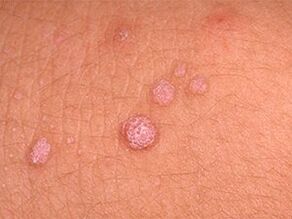Papillomas on the body are similar situations in dermatological practice.The main locations are armpits, neck, thighs and genitals, and face.Most neoplasms have a tame course, but the risk of transformation into skin cancer or any other localization increases under the influence of various negative factors.
Why is papilloma harmful to the human body?

Virus tumors in the body are usually caused by strains with relatively low oncogenic hazards and minimum risk of cell degeneration.With cell atypia, rapid growth and changes in the features of the papillary lesion structure are observed.
Today, especially dangerous strains include HPV 15, 16, 18, 35, 51-59, 66-68.It is interesting that the location of the cancer tumor during the human papillomavirus infection can be true.
Papillomas on the body appear in the form of neoplasma warty, calluses, flat or genital warts.The dangers and complications caused by HPV are usually different between men and women.
Papillomavirus complications in men
Often he is a man who is a contagious strain carrier and sends it to women through unprotected sexual relations.The main localization of papilloma in the body in men is genital, genitalia, frenulum and foreskin;Papillomas are often formed in the anus in men.Sometimes there is growth in the armpits and the neck.
Symptoms directly depend on the location.Clinical manifestations are more typical for localization of papilloma in the genitals.Usually, neoplasms are not accompanied by obvious symptoms.
The main complications in men are:
- prostate cancer;
- throat and larynx cancer;
- Sexual impotence;
- infertility;
- erectile dysfunction;
- development of adenocarcinoma;
- Malignant intestinal tumor.
The transformation of healthy cells into cells -Cancer cells are facilitated by:
- bad habits,
- difficult working conditions,
- frequent pressure,
- permanent injury to papillary lesions;
- Insufficient hygiene.
Features -Hazardous features in women
In the absence of adequate treatment, HPV in women threatens greater complications due to the uniqueness of the anatomical structure of the genital organs and hormone levels.
The main complications are:
- cervical and complementary cancer;
- vulva displacement, vaginal vault, cervical canal;
- uterine structure carcinoma;
- Large genital warts, if papilloma is diagnosed in the thigh in women;
- malignant changes in pharynx mucous membranes, genital organs;
- Genodermatous warts according to the pathology of Lewandowski-Lutz;
- Esophageal and larynx cancer;
- Plantar cancer.
The localization of warts and condiloma in the lumen of the uretral canal leads to disruption of urine flow.When localized in the larynx - the breathing and the respiratory function are affected.
Unfortunately, many women see any new growth on the skin just from the point of view of cosmetic problems.By removing papillomas, they hope they have solved the HPV problem completely.When the virus infection is active, the released tumor reappears and with greater intensity.
It is important to recognize the signs of neoplasm violence in time:
- Changes in the shape, size and structure of growth;
- Papillary wound instability:
- Painful sensations in the growth area;
- Persistent trauma, bleeding, infection.
Permanent exposure to negative factors contributes to growth instability and stimulates cell changes into cancer.
If papillomas appear, it is recommended to consult a dermatologist to explain the nature of the pathological rash.
Is the papilloma in the body contagious?

Is the papilloma on the body being sent from person to person?Given the high papillomavirus infection, the patient is concerned about the possibility of a virus contract through contact with the virus tumor on the skin.The answer is obvious - it's almost impossible to "catch" the virus when touching papillomas.
However, if the skin of the carrier and the healthy person in the field of contact is damaged, the risk of infection increases.
There are other ways for the delivery of infection:
- sexual relations;
- labor activity;
- Contact-home route (during a long stay with a virus carrier).
You can also be infected in public places, especially in bath houses, sauna, locker rooms, and swimming pools.
There is a concept of self -infection, when an injured papilloma causes many others across the body.
The penetration of the virus into the human body does not mean that the skin rash should appear after some time.With a high immune response from the human body, the amount of antibody is sufficient to suppress the virus activity from any strain, and to a good health background, the virus does not appear until the end of life.
Of course, even if a person has no symptoms, he or she is still a carrier of viral infection.
Many papillomas have appeared in the body, what does it mean?
The appearance of papilloma on various locations characterizes the activation of the virus strain.Various papillomatous foci signals the increased risk of growth of growth.The increase in pathogenic activity of the virus strains is due to reduced immunity with continuous progressive courses.
The following can cause decreases in the body's immune response:
- cold;
- hypothermia;
- stress factors;
- alcohol and drug addiction;
- persistent hormone disorders;
- pregnancy, abortion;
- Chronic pathology of the internal organs.
Virus activities can be triggered by easy failure to adhere to personal hygiene rules.Somatically, various papilloma describes the pathology of organ and internal systems.HPV is often combined with other viral diseases, for example, herpes infection.
Papillomas have spread throughout the body - what to do?

When various papillomas appear, it is important to undergo a differential diagnosis.Professional doctors usually record the rash and indicate the possible causes of tumors.
The main research method is:
- blood tests for antibodies to viruses;
- Digen tests to identify types of tension, virus structure and oncogenic hazard levels;
- polymerase chain reaction to detect viral DNA;
- Cytological examination of biological material from the cervical canal;
- Histological examination of sample from female genital organs;
- Wart or condyloma analysis.
Early diagnosis is usually made during the patient's first examination.Based on the results of the patient's research and clinical history, virus infections are diagnosed or excluded.It is important to separate HPV from dermatological diseases, cancer and herpes virus.
Against the papillomas in the body
Today there is no effective therapy for viral infections, but formal drugs can create conditions for stable forgiveness and prevention of skin rash.The infection itself is harmless, but the formation of papilloma increases the risk of cell violence and the appearance of tumors.
Treatment
The promising direction is drug therapy:
- Immunomodulators based on interferon to stimulate the immune system;
- Antiviral agents;
- Vitamins to create strong immunity and restore the body;
- Local preparations for removing papilloma.
In the event of secondary infections, bacterial therapy and antiseptic treatment are prescribed.
Non-steroidal anti-inflammatory drugs are ideal for relieving pain.
Removal
Tumor removal is possible with modern hardware techniques and cosmetic surgery.
There are several effective methods for tumor isolation:
- Scalpel;
- laser;
- radio waves;
- Cryodestruction;
- chemical;
- Electrocoagulation.
No operation prevents the formation of further pathological growth.Without adequate antiviral treatment, the removal of external signs only provides temporary results.
HPV is a common infection that can be contracted through sexual relations, as well as through regular kisses.The main prevention is to vaccinate children at the age of 12-14 years before the first sexual experience.It is important to monitor skin and genital hygiene.Unfortunately, although contraceptive barrier methods cannot guarantee 100% protection against human papillomavirus infections.Timely response to the patient for rash is key to safe and fast treatment, including preventing the risk of cancerous tumors.























